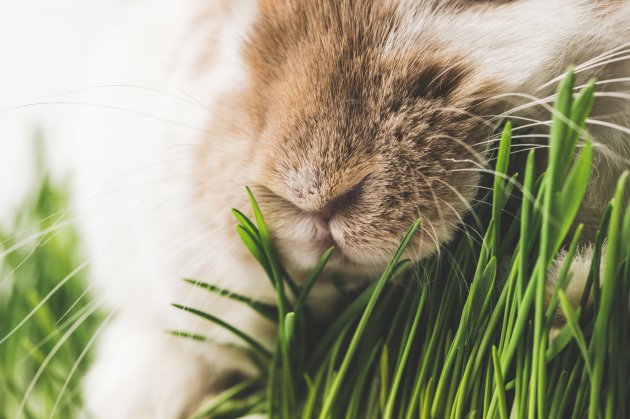Having a pet bunny can be a rewarding experience, even more so if you can allow him to roam around your home. However, having a cage-free bunny is not as simple as a cat or dog would be.
In this post, we will explore the 9 things you need to know before your bunny goes cage-free.

Know Every Room
Before you allow your pet bunny free-access to your home, you will want to know every room - meaning, you will have to make each area your pet has access to safe. Generally, rooms that are the easiest to bunny-proof are the bathroom, laundry room, bedroom, and kitchen.
Know to Bunny-Proof the Electrical Wires
Rabbits are notorious for chewing electrical cords - this practice not only destroys the cord, but it can be harmful (and even deadly) to your furry pal. To keep your rabbit safe, you will have to either remove the cords from the bunny’s reach (ie tape them on the wall) or cover them up.
To cover exposed cords use protective tubing (found at hardware or electronic stores). This special tubing is also called vacuum tubing, polygon tubing, and plumber’s tubing. It is available in many different types of plastics, thicknesses, and sizes. They can also be soft and bendable or hard.
When bunny-proofing a room, be sure to check for hidden cords that your rabbit may still have access to like under a bed or behind a dresser or shelving unit.
Know to Bunny-Proof the Walls
Some pet bunnies will chew on the corner (or an area) of a wall or window frame. To determine if your pet is one of those “corner-chewers” you will have to observe his behavior when he is running about. If you notice that he is gnawing at a corner, you can purchase hard plastic or wooden corner protectors that should deter your bunny from nibbling those areas.
Know That Bunnies May Chew on Furniture
If your cage-free bunny has taken to gnawing on the legs of your furniture, you may want to try a product called, ‘Bitter Apple’ (available online and at pet retailers). This product tastes terrible and is usually enough to stop Fluffy from further chewing-exploits. However, to any pet parent’s dismay, some rabbits don’t mind the flavor and will continue to chew on the spot. For these taste-bud-challenged pets, you may have to wrap the furniture legs with cardboard.

Know Bunnies Need Toys - Lots of Them!
To help keep your bunny busy (and away from things it shouldn’t be chewing on) provide him with plenty of toys in every room he has access to. These can be wooden blocks, baskets, cardboard boxes, and other bunny-approved items. Just be sure the toys are natural and have not been treated with paints, stains or varnishes. Also avoid any item made from pressboard, plywood, pressure-treated wood, or particleboard.
Know Toxic Plants
Your pet bunny may also chew on household plants. To keep him safe, hang your houseplants from the ceiling or put them up on high shelves or planters. Also, be sure to pick up or vacuum any fallen leaves or flowers that your bunny may happen upon. There are several toxic house plants including azalea, daffodils, hyacinth, and holly. For a complete list of toxic plants click here to visit the House Rabbit Society.
Know How to Litter Box Train
A cage-free bunny must be litter box trained.
Note: spayed and neutered rabbits are easier to train as this procedure reduces their urges to mark their territory.
The first thing you will want to do is to purchase a suitable litter pan (those designed for cats work well). Choose a spot to keep your bunny’s litter pan (ceramic or other tiled floorings that are easily washed works best).
Once the litter pan is placed, add a thin layer of litter, then spread some hay around (bunnies like to nibble while doing their “business”).
While you are in the process of litter training your bunny, keep him confined to the same room the litter box is located. If you notice your pet is having accidents, use a paper towel to clean up the droppings with, then place them in the litter box - this helps to reinforce the litter box’s purpose.
Note: litter box training a bunny can take upwards of two weeks.

Know About Food & Water Location
Providing your pet bunny with top nutrition goes without saying, but you will also have to have a good location for your rabbit’s dietary needs. When choosing a spot to put your rabbit’s food and water bowls, be sure they are not located in a high traffic zone - your bunny will want to eat and drink at its leisure without being tripped over or constantly disturbed. You will also want to have the location one that is easily cleaned due to spills and other mishaps. Lastly, try to put your bunny’s food away from the litter box - who wants to eat near their toilet?
Know to Go Slow
Even if you have bunny-proofed your entire home, it’s still important to slowly expand your bunny’s territory. This allows for your pet to learn the litter box-ropes, where his food and water are located, and also for you to learn your pet’s chewing and free-roaming habits. If your bunny stops using the litter box when you expand its territory, simply go back to the reduced-amount of roaming area for a few days, then try again.
Conclusion
Having a cage-free bunny is great for both you and your pet, but there will be work involved to get your fluffy pal to that point. Follow our tips and tricks to having a successful cage-free bunny. If you decide that a free-roaming rabbit is not for you, check out the Best Cages For Your Rabbit.